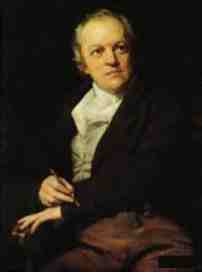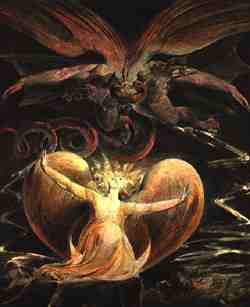» William Blake Biographyby Marion Phillips - February 5, 2004 |
 William
Blake was a very creative man and a rebel, who questioned the rules of his
society and was never appreciated either accepted by it through his life.
William
Blake was a very creative man and a rebel, who questioned the rules of his
society and was never appreciated either accepted by it through his life.
Nevertheless his works were an important influence to artists as diverse as Salvador Dali and Jim Morrison.
Swimming Against The Tide
It's not easy to categorize Blake, because he was a master in several arts. He was a poet, a painter, an engraver and the few books he produced, he created them almost completely by himself (the only help he had was his wife's), from the illustrations to the printing.
William Blake was born in London, UK in 1757, son of a hosier. He was firstly educated by his mother and worked in his father's shop until 1767, when he was sent to the school of Henry Pars to learn drawing.
At the age of 14, he started his 7 years apprenticeship with the engraver James Basire, being much influenced by Gothic Art. By the end of it, he was 21 years old, and he started to work as a professional engraver.
In 1783 he married Catherine Boucher and taught her how to draw and paint. Her support of his work would be invaluable and when he started to publish his books, all the painting work was done by her.
Blake's first books were "Poetical Sketches", published in 1783, "Songs Of Innocence" of 1789 and "Songs Of Experience" of 1794. The poems are beautiful and melodious, but also poignant and they already showed a direct critic to the society of his days.
His most famous poem "The Tiger" is part of the "Songs Of Innocence" book, and it's a good example of his intelligent and creative style: "Tiger, tiger, burning bright/In the forests of the night,/What immortal hand or eye/Dare frame thy fearful symmetry?"
 There
were also his more rebellious works: "The Marriage of Heaven and Hell"
(1790), "The Book of Urizen" (1794) and "Milton" (1804-8),
among others.
There
were also his more rebellious works: "The Marriage of Heaven and Hell"
(1790), "The Book of Urizen" (1794) and "Milton" (1804-8),
among others.
All these works have a strong mystical theme, like the "Marriage..." book that has questions on the logic of the Catholic religion.
In 1800, he met William Halley, who became his patron and sponsored Blake's work to illustrate a book on the life of Cowper and paid him to create busts of famous poets for his house in Surrey.
Two of his late works were the illustrations he did to a version of Dante's Divine Comedy and others to the Bible's Book Of Job.
Blake never made much money from the selling of his works, in part because of a lack of cunning to deal with business and in part for a lack of interest in getting rich.
He always faced financial problems, especially because his personal method of printing was very expensive. However when he died in 1827, he left no debts.
In life he was considered by his own friends an eccentric and somewhat mad man and by his society a subversive and heretic. He was buried in Bunhill Fields in a public cemetery and in an unmarked grave.
By the end of the 19th century, his works started to be rediscovered and his personality became a legend.
Download two of his works now! (ZIP file size: 39 KB)
Contents:
- Poems
- Songs Of Innocence & Songs of Experience
If you want more information:
*This work's rights belong to the author. No reproduction allowed without the author's consent. If you want to link to this article from your site, please read our privacy policy about it. Thank you!*
::: home ::: library section :::
Copyright © 2004 Marion Phillips